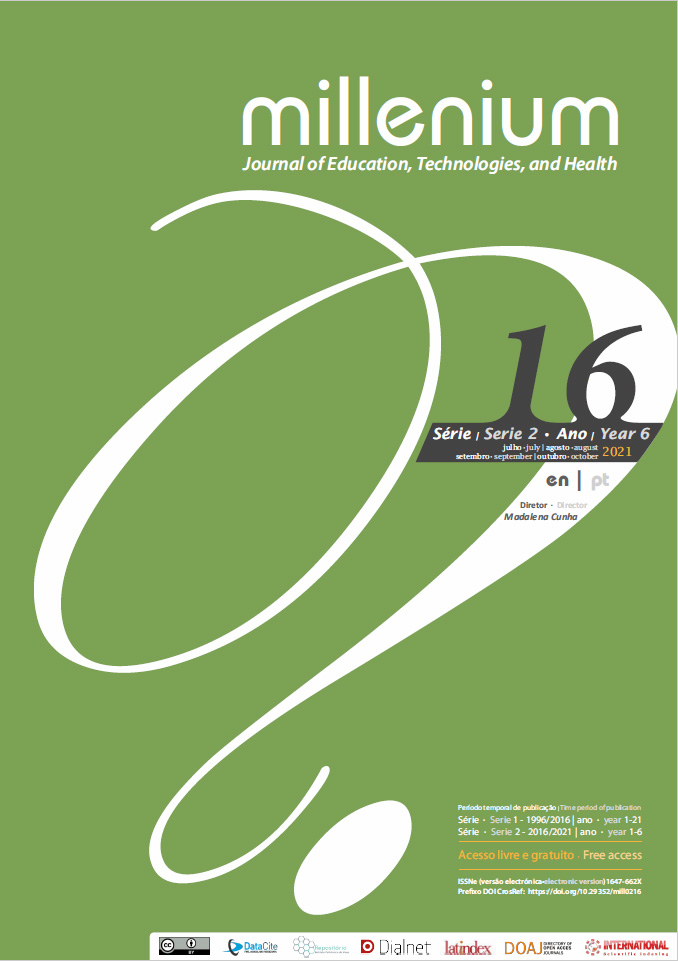Fatores que influenciam a prática simulada na formação em enfermagem
scoping review
DOI:
https://doi.org/10.29352/mill0216.24976Palavras-chave:
enfermagem, simulação, practice guidelinesResumo
Introdução: A elaboração de um cenário de simulação requer uma planificação estratégica que permita guiar a prática simulada, de forma a contribuir positivamente para o desenvolvimento de competências e uma prática de excelência dos futuros enfermeiros.
Objetivo: Identificar os fatores que influenciam a construção dos cenários de simulação na prática simulada de enfermagem.
Métodos: Estudo de Scoping Review realizado nas bases de dados Scielo, CINAHL PLUS, GreenFILE, Lilacs, PubMed, RCAAP, com a frase booleana “Nursing AND Simulation AND Practice Guidelines”. Foram definidos como critérios de inclusão estudos escritos em português, inglês e espanhol com full text disponível e que envolvessem estudantes do ensino superior de enfermagem, e, portanto, com participantes adultos maiores de 18 anos.
Resultados: Foram incluídos no estudo 10 artigos. Nos estudos identificaram-se fatores que influenciam a construção dos cenários de simulação, entre eles, o equilíbrio entre momentos de prática clínica e discussão com os estudantes, momentos de reflexão, o papel do facilitador, a comunicação facilitador/estudantes, a clara definição dos objetivos e o realismo do cenário.
Conclusão: A prática clínica em enfermagem tem estado sujeita a uma constante evolução, tanto a nível teórico/cientifico, como, a nível prático. A identificação de fatores que influenciam a construção dos cenários de simulação na prática simulada de enfermagem facilita um maior aperfeiçoamento a nível prático e uma redução substancial dos erros clínicos, constituindo-se como um excelente contributo para a Simulação em Enfermagem.
Downloads
Referências
Coutinho, Verónica Rita Dias, Martins, José Carlos Amado, & Pereira, Maria de Fátima Carneiro Ribeiro. (2014). Construção e Validação da Escala de Avaliação do Debriefing associado à Simulação (EADaS). Revista de Enfermagem Referência, serIV(2), 41-50. https://dx.doi.org/10.12707/RIII1392
Costa, R., Medeiros, S., Martins, J., & Coutinho, V. (2018). A Simulação no Ensino de Enfermagem: Reflexões e Justificativas a Luz da Bioética e dos Direitos Humanos. Revista Académicas da Universidade do Chile, 24(1), pp. 31-38. available at https://revistas.uchile.cl/index.php/AB/article/view/49375/51850
Duarte, H., Sousa, P., & Dixe, M. (2017). Validação da versão portuguesa da escala de satisfação dos estudantes de enfermagem relativamente à simulação de alta-fidelidade (ESEE-SAF). Unidade de Investigação em Saúde da Escola Superior de Sáude do Instituto Politécnico de Leiria, pp. 185-196. Available at http://hdl.handle.net/10400.8/2889
Dubrowski, A., Alani, S., Bankovic, T., Crowe, A., & Pollard, M. (2015). Writing Technical Reports for Simulation in Education for Health Professionals: Suggested Guidelines. Cureus, 7(11), pp. 1-8. doi:10.7759/cureus.371
Fortin, M. -F., Côté, J., & Filion , F. (2009). Fundamentos e Etapas do Processo de Investigação. Loures: Lusodidacta.
Gamboa, F., Álvarez, J., Cepeda, R., & Gómez, J. (2019). Instructional Design Model Applied to a Virtual Guide in Clinical Simulation. Universitas Médica, 60(3), pp. 1-14. doi:10.11144/Javeriana.umed60-3.mdis
Herrera, C., Molina, N., & Becerra, J. (2015). Fortalecimiento de La Simulación Clínica como Herramienta Pedagógica en Enfermería: Experencia de Internado. Revista Cuidarte, 6(1), pp. 970-975. doi:10.15649/cuidarte.v6i1.161
Jeffrey, C., Mitchell, M., Henderson, A., Lenthall, S., Knight, S., Glover, P., . . . Groves, M. (2014). The value of best-practice guidelines for OSCEs in a postgraduate program in an Australian remote area setting. Rural and Remote Health, 14(3), pp. 1-9. doi:10.1016/j.nedt.2015.01.007
Jeffries, P. (2015). Signs of Maturity . . . Simulations Are Growing and Getting More Attention. Nursing Education Perspectives, 36, pp. 358-359. doi: 10.5480/1536-5026-36.6.358
Joanna Briggs Institute. (2013). JBI Levels ofEvidence. Acedido em: https://jbi.global/sites/default/files/2019-05/JBI-Levels-ofevidence_2014_0.pdf
Kaneko, R., & Lopes, M. (2019). Realistic health care simulation scenario: what is relevant for its design? Revista da Escola de Enfermagem da Universidade de São Paulo, 53, pp. 1-8. doi:10.1590/S1980-220X2018015703453
Mota, L., Jesus, A., Teixeira, C., Cabral, D., & Trindade, M. (2021). Eficácia da Simulação em Enfermagem na Aprendizagem dos Estudantes. Revista Millenium, 2(15), pp. 25-31. doi:10.29352/mill0215.21267
Page, M., McKenzie, J., Bossuyt, P., Boutron, I., Hoffman, T., Mulrow, C., . . . Moher, D. (2021). The PRISMA 2020 statement: an updated guideline for reporting systematic reviews. The BMJ, pp. 1-9. doi:10.1136/bmj.n71
Silva, A., Silva, G., & Belian, R. (2020). Simulação clínica e educação médica: relato de experiência sobre construção de um cenário de alta fidelidade. Revista de Saúde Digital e Tecnologias Educacionais, 5(1), pp. 99-111. doi:10.36517/resdite.v5.n1.2020.re9
Stephens, J., Brailey, H., & Platt, A. (2011). "Appearing the team": from pratice to simulation. International Journal of Therapy and Rehabilitation, 18(12), pp. 672-682. doi:10.12968/ijtr.2011.18.12.672
Torredà, M., & Collado, A. (2015). Simulation-Based Learning as a Tactic for Teaching Evidence-Based Practice. Worldviews on evidence-based nursing, 12(6), pp. 392-394. doi:10.1111/wvn.12107
Vuuren, V. J., Seekoe, E., & Goon, D. T. (2018). The Perceptions of Nurse Educators Regarding the Use of High Fidelity Simulation in Nursing Education. Africa Journal of Nursing and Midwifery, 20(1), 1-20. doi:10.25159/2520-5293/1685
Downloads
Publicado
Como Citar
Edição
Secção
Licença

Este trabalho encontra-se publicado com a Licença Internacional Creative Commons Atribuição 4.0.
Os autores que submetem propostas para esta revista concordam com os seguintes termos:
a) Os artigos são publicados segundo a licença Licença Creative Commons (CC BY 4.0), conformando regime open-access, sem qualquer custo para o autor ou para o leitor;
b) Os autores conservam os direitos de autor e concedem à revista o direito de primeira publicação, permitindo-se a partilha livre do trabalho, desde que seja corretamente atribuída a autoria e publicação inicial nesta revista.
c) Os autores têm autorização para assumir contratos adicionais separadamente, para distribuição não-exclusiva da versão do trabalho publicada nesta revista (ex.: publicar em repositório institucional ou como capítulo de livro), com reconhecimento de autoria e publicação inicial nesta revista.
d) Os autores têm permissão e são estimulados a publicar e distribuir o seu trabalho online (ex.: em repositórios institucionais ou na sua página pessoal) já que isso pode gerar alterações produtivas, bem como aumentar o impacto e a citação do trabalho publica
Documentos necessários à submissão
Template do artigo (formato editável)















